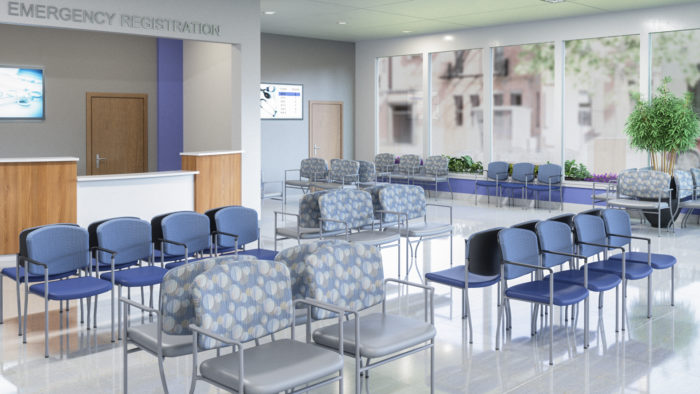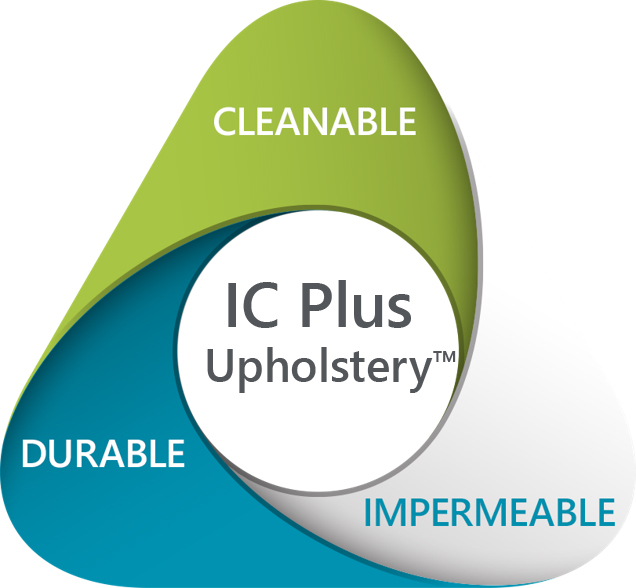REIMAGINING PATIENT WAITING AREAS AFTER COVID-19
Reduce healthcare-associated infection (HAI) with better protocols that save costs and enhance the patient experience.
How do you design an inviting waiting space that welcomes patients without also inviting risks for contamination? It’s the challenge that healthcare settings have always faced. However, the urgency for creating safe and sterile waiting areas, consultation areas, rehabilitation areas, treatment areas and examination areas has intensified from COVID-19 impact.
The Provincial Infection Control Network of British Columbia cites the risk for healthcare-associated infection (HAI) as a significant patient safety issue and economic burden for the healthcare system. Within Canada, one in nine hospital patients contracts an HAI. The 220,000 cases of HAI that occur each year within Canada’s hospitals result in 8,000 deaths. In the United States, the Centers for Disease Control (CDC) reports that one in 25 U.S. hospital patients is diagnosed with at least one infection related to hospital care. This high infection rate culminates in approximately 722,000 infections with 75,000 deaths. In addition to a toll on human well-being, the high HAI rate in the United States leads to up to $33 billion in excess costs annually.
One of the most basic ways to mitigate HAI risks is through sourcing durable surfaces that can withstand intense cleanability.
One of the most basic ways to mitigate HAI risks is through sourcing durable surfaces that can withstand intense cleanability. Surprisingly, not all medical offices and care clinics utilize spread-mitigating furniture and fabrics in their waiting areas and treatment rooms. COVID-19 and other respiratory viruses are primarily spread from small droplets released from the noses and mouths of infected people when they cough, sneeze or breathe. One cough can produce up to 3,000 droplets that are capable of landing on surfaces in all directions. While research is still emerging regarding how long the virus can stay on surfaces, we know from existing research on other coronaviruses like SARS and MERS that these particles can easily survive on surfaces for up to 9 days when surfaces are not adequately disinfected. In some cases, these particles can linger for as long as 28 days.
How to Foster Infection Prevention in Seated Areas
The answer to infection prevention in seated areas in healthcare settings is not to prevent people from sitting. In fact, setting up a space with safely distanced seating is one of the more effective ways to prevent crowding in medical offices. There is also the reality that sitting is necessary for many patients due to mobility and comfort issues. A better strategy is to control occupancy and flow by carefully arranging seating that can be easily and thoroughly cleaned. However, many facilities are using “office grade” furniture in their clinical spaces. This requires hospitals, medical offices and clinics that aren’t using medical-grade furniture in their waiting areas to review their practices. Here’s a look at the disadvantage of using regular office furniture in healthcare settings:
- Upholstery with cracks, tears and punctures are common due to the high traffic seen in waiting rooms.
- Compromised, unsightly upholstery creates diminished guest experiences and patient confidence.
- Compromised upholstery increases the risk for hospital-associated infections (HAIs) because exposed padding creates crevices where viruses and bacteria can nest.

The problem is that most office furniture is really intended for single-person usage. This is precisely why it is not meant to be used in settings like restaurants, movie theaters or hospitals. However, many medical offices and clinics use office furniture that is not appropriate for such a high-transmission setting. What’s more, the lack of durability of office furniture creates a very costly cycle of replacing furniture frequently. This is precisely why so many healthcare practices seeking ways to reduce healthcare-associated infections (HAIs) are switching to IC Plus Upholstery™.
IC Plus Upholstery™: The Cleaner, Better Way To Manage Seating in Healthcare Settings Plus in Passive Preparedness
Patented IC Plus Upholstery™ makes it possible to rigorously and continuously disinfect hospital chairs using hospital-grade cleaners capable of removing up to 98.68% of microorganisms from surfaces. By contrast, standard upholstery used on ordinary office furniture will simply prematurely deteriorate under this type of cleaning protocol. Even medical-grade vinyl doesn’t allow for such extreme disinfection. In fact, IC Plus Upholstery allows you to remove about 30% more microorganisms from surfaces than even medical-grade vinyl. However, the real benefits of this hyper-hygienic material start before post-use disinfection.
The Preventative Benefits of Sealed, Seamless Chairs in Healthcare Settings

Unlike upholstery that is cut and sewn, IC Plus Upholstery is “spray-applied” over a foam and fabric base. This creates a fully sealed, seamless design that forms an impenetrable barrier. Once sealed, this nonporous upholstery creates a barrier against the following:
- Fluids
- Dirt
- Bed Bugs
- Pathogens
- Mold
IC Plus Upholstery is five to 10 times stronger than the medical-grade vinyl commonly used in clinical medical spaces. When using IC Plus, clinical spaces enjoy greater longevity in the face of high patient volume. For practices or clinics that see hundreds of patients per day, that can add up to years of prolonged usage without the costs of repairing or replacing furniture. In fact, IC Plus Upholstery has a 10-year guarantee against all punctures, tears and cracks.



